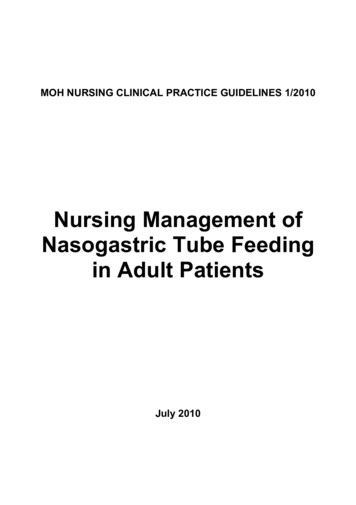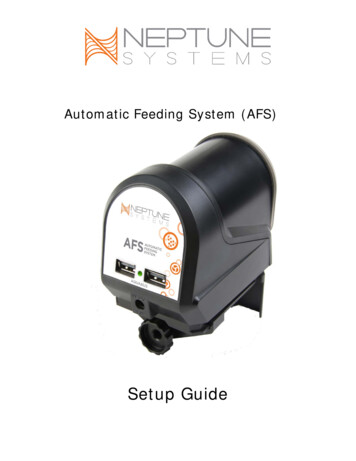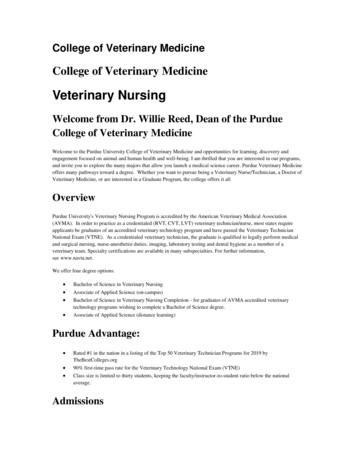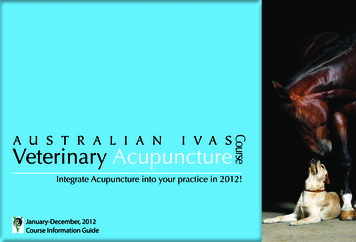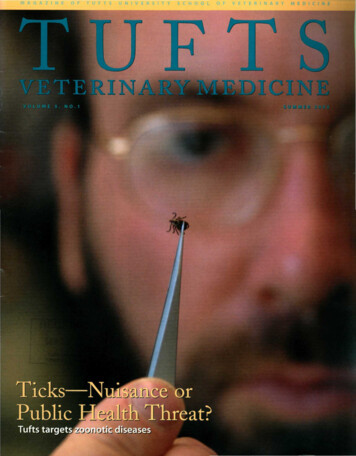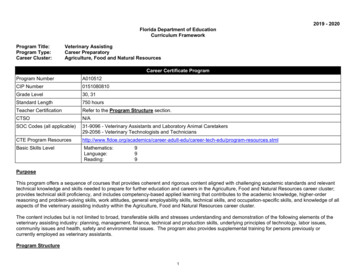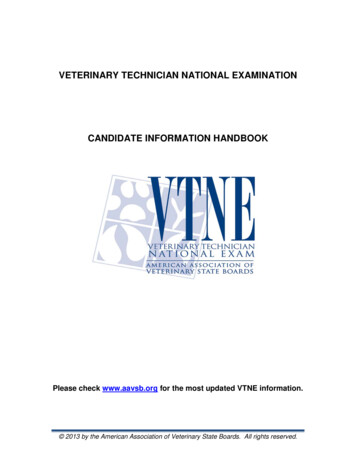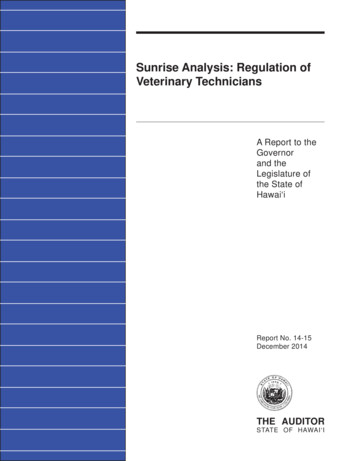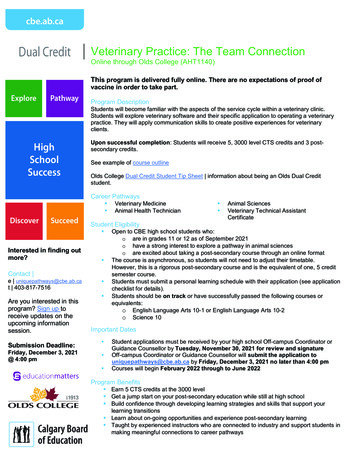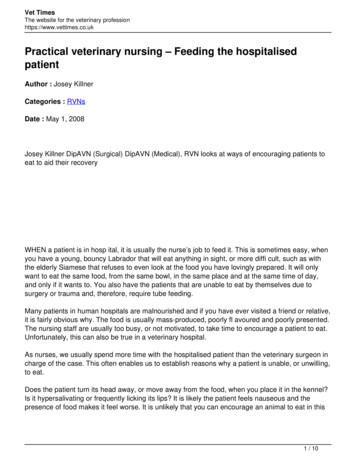
Transcription
Vet TimesThe website for the veterinary professionhttps://www.vettimes.co.ukPractical veterinary nursing – Feeding the hospitalisedpatientAuthor : Josey KillnerCategories : RVNsDate : May 1, 2008Josey Killner DipAVN (Surgical) DipAVN (Medical), RVN looks at ways of encouraging patients toeat to aid their recoveryWHEN a patient is in hosp ital, it is usually the nurse’s job to feed it. This is sometimes easy, whenyou have a young, bouncy Labrador that will eat anything in sight, or more diffi cult, such as withthe elderly Siamese that refuses to even look at the food you have lovingly prepared. It will onlywant to eat the same food, from the same bowl, in the same place and at the same time of day,and only if it wants to. You also have the patients that are unable to eat by themselves due tosurgery or trauma and, therefore, require tube feeding.Many patients in human hospitals are malnourished and if you have ever visited a friend or relative,it is fairly obvious why. The food is usually mass-produced, poorly fl avoured and poorly presented.The nursing staff are usually too busy, or not motivated, to take time to encourage a patient to eat.Unfortunately, this can also be true in a veterinary hospital.As nurses, we usually spend more time with the hospitalised patient than the veterinary surgeon incharge of the case. This often enables us to establish reasons why a patient is unable, or unwilling,to eat.Does the patient turn its head away, or move away from the food, when you place it in the kennel?Is it hypersalivating or frequently licking its lips? It is likely the patient feels nauseous and thepresence of food makes it feel worse. It is unlikely that you can encourage an animal to eat in this1 / 10
situation. Trying may make the patient resentful and unwilling to establish any relationship with you.It is important that the veterinary surgeon is informed, as it may be possible to administer an antiemetic, if not contraindicated, and subsequently the patient may eat. Anti-emetics, such asmetaclopramide (available as a tablet, liquid or injectable) and maropitant (Cerenia, Pfi zer:available as an injectable or tablet), may be used for treating nausea or vomiting.Distrustful patientIf a patient just ignores the food, it may be because it is protesting at the situation or distrustful ofyou or the environment it is in.This can often be overcome by establishing a rapport with the patient. Call the animal by its name;talk calmly and gently; and petit. Find out what time of day it is usually fed. Use a dish that isfamiliar; for instance, if it usually eats out of a ceramic bowl, a metal one may be rejected.Establish what food an animal usually eats by asking its owner and, if necessary, request he or shebrings some in. See if the owner would be willing to encourage the pet to eat. TLC should never beunderrated and is one of a nurse’s strongest attributes in these situations. All this information willmake your job of nursing the patient easier and ultimately more rewarding.A patient may not be eating because it is in pain. Pain is demonstrated in many different ways,from sitting quietly at the back of the kennel to growling or hissing at anyone who gets too close. Ananimal that has adequate analgesia is more likely to eat, heal quicker and be a generally happierpatient. Speak to the veterinary surgeon if you feel a patient requires analgesia.Good nutrition is vital to an animal’s ability to heal. Good nutrition does not mean feeding largequantities of chicken or fi sh. These foods contain protein only and do not provide a balanced diet.They may be used to stimulate a patient’s appetite if it is not willing to eat a more nutritionallybalance diet, but should not be fed long term. Once a patient is eating, try introducing other foodslike Hill’s a/d or i/d (available now in tins or pouches) or Royal Canin Convalescence, or SensitivityControl. These foods may also be warmed to body temperature, as smell is very important toanimals, and warmed food will often be accepted when other foods are ignored. Do not overheatthe food as this destroys the nutritional value and makes the food less likely to be accepted. Smallquantities of food can be left with the patient, but don’t leave the food for too long. It becomes staleand unappetising very quickly. After a couple of hours, change the food or even have a smallperiod of time where no food is given, as interest may be evoked when food is next offered.Some patients will eat while petted, while others prefer to eat late at night when the surgery isquieter. It is important to get to know your patient and how they are best fed.Syringe feeding2 / 10
Syringe, or force-feeding, may be used just to stimulate the appetite of a patient that refuses to eat,but should not be maintained if the patient still refuses to eat. Syringe feeding is often stressful forthe patient and may destroy the relationship between the nursing team and the animal. If thepatient resists while being fed it is also burning up vital calories at a time when you are trying tointroduce more. If a patient is refusing to eat despite all efforts, tube feeding may be instigated. Anaso-oesophageal tube can be placed, by a nurse and without the use of a general anaesthetic orsedation, if the patient is compliant. A small amount of local anaesthetic is applied to the nares.Choose the widest feeding tube that will pass through the nostril. Measure the tube from the naresto the fi fth rib and mark with a pen. With an assistant holding the patient’s head still, slide the tubeinto the nostril and advance gently, until the mark is reached. Attach tape around the free tube andplace this in the midline on top of the skull, where it can be attached with tissue glue or sutured inplace. An Elizabethan collar can then be fi tted, with the tube attached to this by tape. A smallamount of saline (2ml) can be syringed down the tube to establish its position in the oesophagus. Ifthe tube is in the trachea, this may evoke a cough. A lateral, thoracic radiograph may also be takento ensure the tube is in the oesophagus and not the trachea. Once the tube is in place, a feedingplan can be drawn up. Prepared liquid feeds are high in calories and nutritional value. A number ofliquid diets are available to feed, such as Fortol, Hill’s a/d and Royal Canin Convalescence diet. Ifa specifi c diet is required, this can be liquidised using a food processor or hand-held blender. Asthe patient has not eaten for a period of time it is important to introduce food gradually and build upquantities over a few days.Working out calorific requirementTo calculate the daily calorifi c requirement (resting energy requirement, RER) for a patientweighing more than 2kg, use the following formula: RER in kcal/day 30(bodyweight in kg) 70. Day one, give a third of the patient’s calorific requirement. Day two, give two-thirds of the patient’s calorifi c requirement. Day three, give the entire daily food requirement. Fluid should be syringed through the tube bothbefore and after the feed. The amount of water given should make up the balance of the foodgiven. Therefore, when a third of the food quantity is given, then two-thirds should be given aswater. It is important that the food and water are warmed to body temperature. Write all food givenon the feeding plan. If any vomiting occurs then the veterinary surgeon should be informed and thefeeding plan adjusted.A patient’s condition may dictate that it eats a particular food while in hospital. Unless this is abland diet, such as Hills i/d or Royal Canin Sensitivity Control, the food should be introducedgradually. Animals do not usually like a sudden change in their normal diet and it may also cause a3 / 10
gastrointestinal problem. Some diets, such as a renal diet, are very high in fat, which replaces theenergy that has been reduced due to the lowered protein content. High-fat diets, particularly ifintroduced too quickly, may result in the patient having diarrhoea. A patient with diarrhoea oftenrequires starving, and that is not what we are trying to achieve. If the veterinary surgeon requests adiet, suggest it is introduced gradually. Generally, vets are not interested in knowing about dietaryissues, but will certainly be happier if patients do not develop further conditions while in their care.A diet introduced over fi ve days is less likely to cause gastrointestinal problems and is more likelyto be accepted by the patient. On day one, add a small amount of the new food to the patient’susual diet and mix it in. If accepted, repeat this at the next meal and gradually increase the quantityof the new food and decrease the old food until the point where the whole diet has been changed.It is particularly important that a hospitalised cat does not go without eating for more than 72 hours,as this may lead to further complications – such as hepatic lipidosis. This is a condition that resultsfrom excessive fat loss from cells that are unable to be metabolised by the liver. Fat accumulationin the liver causes damage due to swelling of the liver cells, fatty deposits and other processes.Hepatic lipidosis is a serious condition that can result in death of a patient. This is more common inoverweight cats, so it is even more important that these patients eat, even if you think they need tolose weight. Patients in hospital may develop food aversions to diets. This may result in themrefusing to eat the food once they are home, as they associate it with their time in hospital. It ispossibly better to avoid diets the patient is expected to eat long term.Although a lively Labrador may eat everything offered, that doesn’t mean it is not susceptible tobeing malnourished. Weigh each patient daily to ensure it remains stable or increases its weight.Check the amount of food each patient requires for its weight. Write this on its daily hospitalisationsheet so everyone is aware. A dehydrated patient placed on intravenous fluids may dramaticallyincrease its weight and this is not related to its food intake, but a reversal of the dehydration.It may be helpful if a chart is drawn up and kept in the kennel room, indicating the quantities of foodrequired for the weight of each patient. When offering the patient food, ensure the quantity is notedand, if taken, how much is eaten. This will ensure the correct amount is consumed. Hospitalisedpatients may have a slightly higher calorie requirement due to their injuries or disease process, andthe amount of extra work their bodies are doing. This is why a daily weight is important as eachanimal has a different metabolism and quantities suggested by food manufacturers are an average.Alter the amount of food given if it is inadequate. Nursing can be rewarding when patients you carefor respond. Achieving the goal of a patient eating and, therefore, improving is satisfying andshould never be underestimated.4 / 10
Veterinary nurses often spend the most time with hospitalised patients, so are ideallyplaced to monitor if they are eating enough.5 / 10
While many patients may be encouraged to eat, the nurse may have to instigate syringefeeding in some cases.6 / 10
While many patients may be encouraged to eat, the nurse may have to instigate syringefeeding in some cases.7 / 10
A nasooesophageal feeding tube can be secured on the midline on top of the skull. AnElizabethan collar can then be fi tted, with the tube attached to this with tape.8 / 10
A nasooesophageal feeding tube can be secured on the midline on top of the skull. AnElizabethan collar can then be fi tted, with the tube attached to this with tape.9 / 10
10 / 10Powered by TCPDF (www.tcpdf.org)
from excessive fat loss from cells that are unable to be metabolised by the liver. Fat accumulation in the liver causes damage due to swelling of the liver cells, fatty deposits and other processes. Hepatic lipidosis is a serious condition that can result in death of a patient. This is more common in


